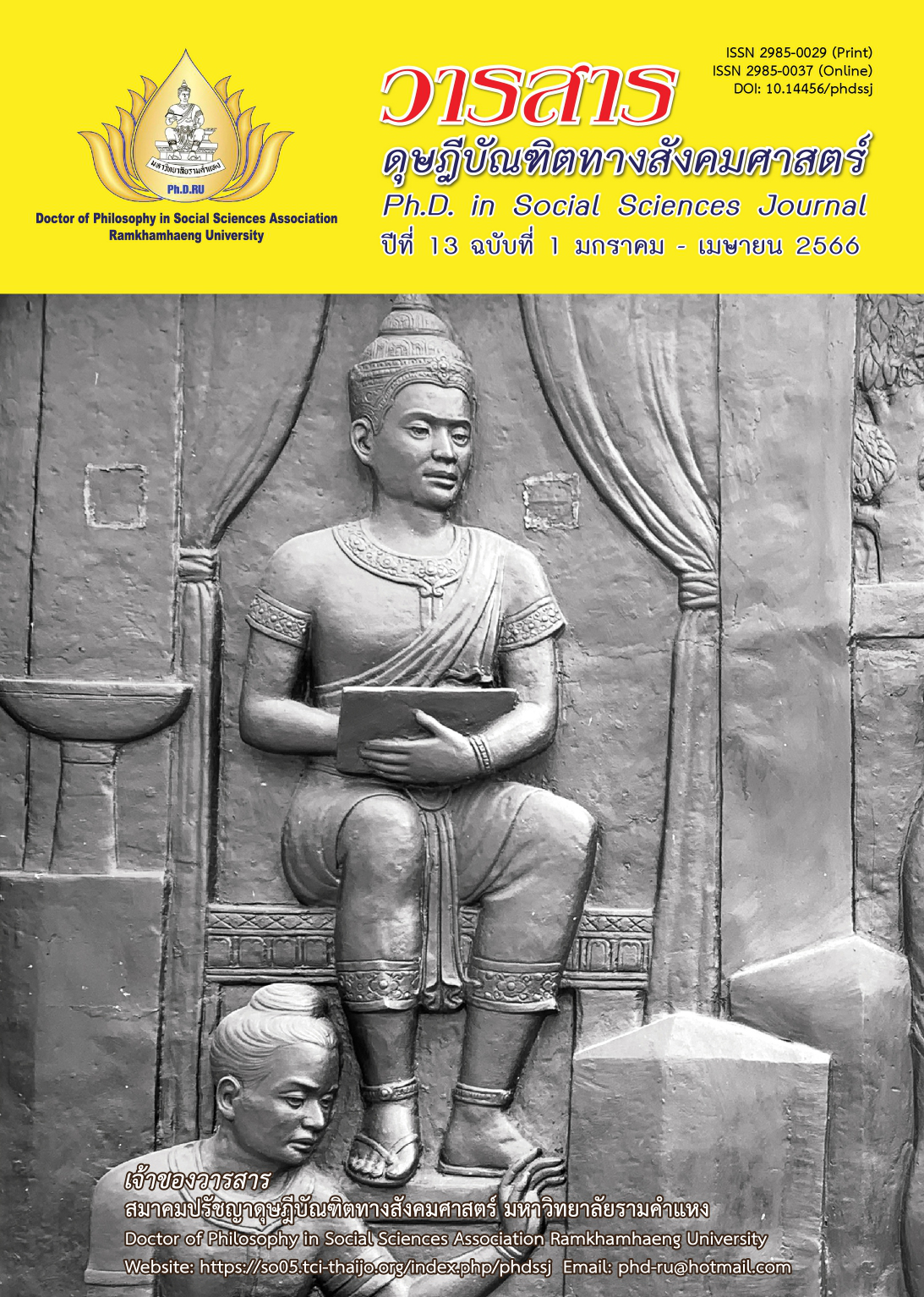The Study Guidelines for Innovative Development from Ergonomics and Fatigue Analyze of Worker’s in the Para Rubber Industry
Main Article Content
Abstract
This academic article aims to analyze the guidelines for artifact innovation to replace human labor with ergonomics and analysis of the work fatigue of employees. A case study in Para rubber was conducted to examine the exportation of cash crops which was arranged through extensive plantations in the country. By bringing the concept of innovative development concept, Ergonomics concept and the concept of fatigue in work as a framework for analysis.
The results of the analysis revealed that: in the manufacturing sector of the Para Rubber Industry, manual labor was also used in the rubber smoke sheets processing the workers had an unnecessary movement that related to ergonomics risk and fatigue. Thus, innovation and technological development are helpful and important to the employees. The start of analysis to study concerning ergonomics and fatigue in work were relevant for improving in work. Ergonomics analysis and fatigue assessment by the Piper method in the maximum Abnormal Index score was a conveying step. Based on the results, the ergonomic problem analysis must be immediately corrected. And the fatigue assessment showed that workers had the fatigue in conveying steps. The analyses provided guidelines to solve the problems of the workers as regards producing smoked rubber sheets. The concept of the smoked rubber sheet conveyor equipment to increase efficiency in the para rubber industry.
Article Details

This work is licensed under a Creative Commons Attribution-NonCommercial-NoDerivatives 4.0 International License.
Academic articles, research articles, and book reviews in the Ph.D. in Social Sciences Journal are author’s opinions, and not the publisher’s, and is not the responsibility of the Ph.D. in Social Sciences Journal Philosophy Association, Ramkhamhaeng University. (In the case that research is done on human, the researcher has to be trained in Ethics for Doing Research on Human Training and has to produce the evidence of the training).
References
Aksornpan, P., Suthakorn, W., & Lertpoonwilikul, W. (2012). Occupational health hazards and health status related to risk among workers in a smoked rubber sheet plant. Nursing Journal, 39(3), 26-37. [In Thai]
Croitoru, A. (2012). Schumpeter, J. A., 1934 (2008), The theory of economic development: An inquiry into profits, capital, credit, interest and the business cycle. Journal of Comparative Research in Anthropology and Sociology, 30(2), 137-148.
Du Plessis, M. (2007). The role of knowledge management in innovation. The Journal of Knowledge Management, 11(4), 20-29.
Grandjean, E. (1979). Fatigue in industry. British Journal of Industrial Medicine, 36, 175-186.
Hignett, S., & McAtamney, L. (2000). Rapid Entire Body Assessment (REBA). Applied Ergonomics, 31(2), 201-205.
Hyer, N., & Wemmerlov, U. (2002). Reorganizing the factory: Competing through cellular manufacturing. Productivity Press.
Intaranont, K. (2016). Ergonomics. Chulalongkorn University Press. [In Thai]
Jantarapimol, Y., Chanprasit, C., & Songkham, W. (2007). Health status and health preventive behaviors among rubber plantation workers. The Journal Public Health, 16(3), 390-399. [In Thai]
Kittiban, K., Cheevakasemsook, A., & Phuangsomjit, C. (2020). Occupational fatigue management in professional nurses at Phra Nakhon Si Ayutthaya hospital. Thai Journal of Cardio-Thoracic Nursing, 32(1), 121-136. [In Thai]
Limaroon, P., Narmprasert, P., & Smitipong, W. (2020). Rubber tapping robot for agriculturist 4.0 alternative. Para Rubber Bulletin, 43(1), 25-29. [In Thai]
Madtharak, W. (2021). Ergonomics design. Songkhla Rajabhat University, Faculty of Industrial Technology, Industrial Management Technology Program. [In Thai]
Manmeun, S. (2013). The future para rubber in ASEAN economic community. Para Rubber Bulletin, 34(1), 7-16. [In Thai]
McAtamney, L., & Corlett, E. N. (1993). RULA: Survey method for the investigation of work related upper limb disorder. Applied Ergonomics, 24(2), 91-99.
Ministry of Agriculture and Cooperatives, National Bureau of Agricultural Commodity and Food Standards. (2013). Good manufacturing practices for ribbed smoked sheet. Retrieved from https://www.acfs.go.th/standard/download/GMP-RIBBED-SMOKED-SHEET.pdf [In Thai]
Muchinsky, P. M. (2000). Psychology applied to work: An introduction to industrial and organizational psychology (6th ed). Wadsworth/Thomson Learning.
Office of the Royal Society. (2011). Innovation: Royal Institute Dictionary B.E. 2554. Retrieved from https://dictionary.orst.go.th/index.php [In Thai]
Ong, C. N., & Kogi, K. (1992). Application of ergonomics to developing countries. Oxford University Press.
Piper, B. F. (1993). Fatigue. In V. Carrieri-Kohlman, A. M. Lindsey, & C. M. West (Eds.), Pathophysiological phenomena in nursing: Human responses to illness (2nd ed., pp. 279-302). W. B. Saunders.
Rogers, E. M. (1983). Diffusion of innovation. The Free Press.
Roscoe, J. A., Kaufman, M. E., Matteson-Rusby, S. E., Palesh, O. G., Ryan, J. L., Kohli, S., Perlis, M. L., & Morrow, R. G. (2007). Cancer-related fatigue and sleep disorders. The Oncologist, 12(S1), 35-42.
Rubber Research Institute, Department of Agriculture. (2010). Rubber plantation fund cooperative palace 2010. Retrieved from http://www.thainr.com/uploadfile/20140315181203.pdf [In Thai]
Simachokdee, W., & Chaikul, K. (1997). Ergonomics & science of job arrangement for productivity and safety. (2nd ed). Technology Promotion Association (Thai-Japanese). [In Thai]
Sungkhapong, A., & Pochana, K. (2013). Ergonomics for job improvement. Prince of Songkla University, Faculty of Engineering, Department of Industrial Engineering. [in Thai]
Thamrongvisava, S., Pitanupong, J., & Srisintorn, W. (2019). Burnout and associated factors among nurses at Songklanagarind hospital. The Journal Royal Thai Army Medical, 72(3), 171-185. [In Thai]
Vatjinda, A. (2021). Innovation. Retrieved from https://www.hrcenter.co.th/file/columns/hr_f_20170510_162245.pdf [In Thai]
Wisessathorn, K., & Sriyong, M. (1999). Industrial and organizational psychology. King Mongkut’s Institute of Technology Ladkrabang, Faculty of Industrial Education. [In Thai]


